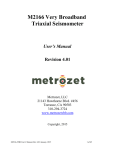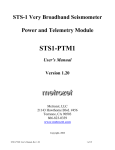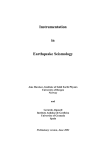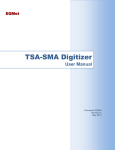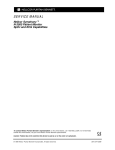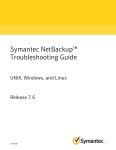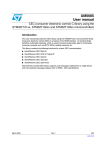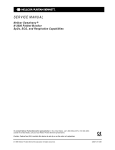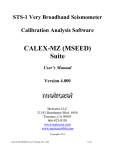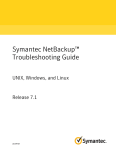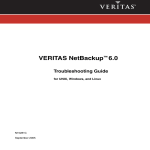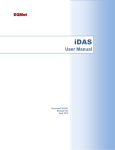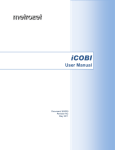Download STS1-E300 User`s Manual
Transcript
STS-1 Very Broadband Seismometer Electronics STS1-E300 User’s Manual Version 1.20 Metrozet, LLC 21143 Hawthorne Blvd. #456 Torrance, CA 90503 866-823-0339 www.metrozet.com Copyright, 2008 STS1-E300 User’s Manual, Rev 1.20 1 of 31 Table of Contents No User-Serviced Parts; Electrical Safety Notice………………………………… p. 3 Introduction and Instrument Description……………………………………….. p. 4 STS1-E300 Package and Connections…………………………………………… pp. 5-7 STS1-E300 Cabling………………………………………………………………. pp. 8-11 STS1-E300 Communications……………………………………………………… p. 12 STS1-E300 Specifications………………………………………………………………. pp. 13-14 Module Interchangeability and Scale Factor Conversion……………………………. p. 15 Operation……………………………………………………………………………….. pp. 16 STS1-E300 Command Software………………………………………………………. p. 17-30 Contact Metrozet………………………………………………………………………. p. 31 Visit www.metrozet.com for the latest version of this manual STS1-E300 User’s Manual, Rev 1.20 2 of 31 No User-Serviced Parts There is no reason to open the instrument case. There are no manual adjustments to make to the electronics and there are no parts that can be user-serviced. Opening the module (and/or altering the tamper-indicating seal), without prior approval of Metrozet, will void the product’s warranty. Electrical Safety Notice As with all electrical instruments, potentially lethal potentials can be present on all metal surfaces, including conductors within any cables. Proper grounding of these elements is important to minimize these risks. The user of this product is responsible for its installation and operation in a safe manner, and in accordance with all local requirements for electrical safety. STS1-E300 User’s Manual, Rev 1.20 3 of 31 Introduction and Instrument Description Metrozet’s STS1-E300 is an advanced electronics package that provides a modern replacement for the original Streckeisen “Feedback Electronics” boxes. It matches the outstanding analog performance of the existing circuitry, while providing a number of enhancements that make installation and operation of the sensors more efficient, within a modern seismic network. These include digital control of all sensor parameters (corner frequency and damping, with a new 10 second setup mode), remote digital control of centering motor operations (including a new, one-step “Auto Center” capability), and a digitally-controlled diagnostic function that allows remote monitoring of all major instrument state-ofhealth parameters (including critical power supply voltages, boom position, signal output levels, motor switch state, electronics temperature, and a number of auxiliary, analog and digital input lines). All of the control and diagnostic functions can be controlled locally (via RS-232, USB, or Ethernet), or remotely (via Ethernet). In addition, the STS1-E300 provides a complete calibration capability that includes on-board generation of velocity or acceleration-equivalent test signals (step, swept-sine, and fixed-frequency sine) as well as automatic switching of calibration test signals into the standard output signal connectors (“Auto CAL”). The latter feature eliminates the need for a separate “calibration signal” recording channel, thus allowing recording of transfer function measurement data (stimulus and response), from triaxial sensors, within a three-channel data acquisition system. The system also maintains the existing capability for injection of user-generated, external calibration signals into the system, through a dedicated connector. All of the control, diagnostic, and calibration features are implemented in an ultra-reliable, “fail-safe” manner. The system is automatically re-configured to operate as a strictly analog sensor, following power-on-reset, or after a pre-determined time without an external command. The STS1-E300 provides the capability for operation and control of three STS-1 sensors. Single and dual-axis versions are also available. This new module improves greatly on packaging, relative to the original electronics. A fully watertight case, along with gastight connectors and cabling, is designed to eliminate a number of moisture-related effects that have plagued the worldwide fleet of STS-1 sensors. Metrozet offers cabling with all critical signals distributed within a twisted-pair configuration. Specifically, Metrozet’s hermetic sensor cable, which is fully-compatible with existing the STS-1 baseplate connector, utilizes a twisted pair configuration for all low-level differential signals. Note that the original, non-hermetic “orange” cables from Streckeisen do not. Each STS1-E300 module is trimmed to provide identical performance on any given STS-1 mechanical sensor. In this way, the electronics are interchangeable between sensors. The exact scalar responsivity of the sensor can be calculated using the “Metrozet STS1Scale Factor Calculator V1.20” software applet that is included with the electronics. In short, the STS1-E300 provides STS-1 users with an improved, and fully-supported, capability for extending the operating lifetime of the world’s highest performance, broadband seismometers. Please contact Metrozet if you have any specific questions or requirements. STS1-E300 User’s Manual, Rev 1.20 4 of 31 STS1-E300 Package and Connections The STS1-E300 electronics are housed in a watertight, die-cast aluminum package. The use of fullyhermetic connectors (Fischer 105 Series gastight bulkhead receptacles and cable plugs) provides a significant improvement over the non-hermetic packaging used in the original Streckeisen boxes and cabling. Figure 1 shows a drawing of the STS1-E300 package with the individual connectors clearly labeled. Tables 1 through 4 provide a pin-by-pin description of each connector. E SENSOR CALIBRATE N SENSOR Z SENSOR STS-1 Very Broadband SEISMOMETER ELECTRONICS STS1-E300 metrozet www.metrozet.com CONTROL S/N: STS1-E300-10-003 E SIGNAL N SIGNAL Z SIGNAL Figure 1. STS1-E300 Package. Note that the three axes are labeled “E”, “N”, and “Z”, in keeping with one popular naming convention for seismic sensor axes. This convention is maintained throughout the entire system (including the software commands, described below). This is, however, simply a naming convention. There is nothing that prevents, for example, one from using three vertical sensors with the STS1-E300 module. Although all three axes would be “Z” axes in this case, the user would still refer to them as “E”, “N”, and “Z”, in using the module and its software. STS1-E300 User’s Manual, Rev 1.20 5 of 31 Pin Name Description Input/Output 1 PDFB+ Proportional Differential Feedback + Output 2 PDFBProportional Differential Feedback Output 3 IFBIntegral Feedback Output 4 IFB+ Integral Feedback + Output 5 DEMDemodulator Input 6 DEM+ Demodulator + Input 7 OSC+ Oscillator + Output 8 OSCOscillator Output 9 MSWMotor Switch Input 10 MSW+ Motor Switch + Input 11 MOT Motor Drive Output 12 MOT+ Motor Drive + Output 13 CALCalibration Coil Output 14 CAL+ Calibration Coil + Output 15 CASE_GND Case Ground Input/Output 16 CASE_GND Case Ground Input/Output 17 NC Unused 18 NC Unused 19 NC Unused 20 NC Unused 21 NC Unused 22 NC Unused 23 NC Unused 24 NC Unused 25 NC Unused 26 NC Unused 27 NC Unused Table 1: SENSOR Connectors pinout description. There are separate connections for E, N, and Z sensors. The connector is Fischer DBPE105Z102-130. Under normal operation these signals are not accessed by the user directly. Pin Name Description Input/Output 1 BRBBroad Band Velocity Output 2 BRB+ Broad Band Velocity + Output 3 LPLong Period Acceleration Output 4 LP+ Long Period Acceleration + Output 5 ANALOG_GND Analog Ground Reference for Signals Input/Output 6 BOOM_POSITION Boom Output 7 CASE_GND Case Ground Input/Output 8 CASE_GND Case Ground Input/Output 9 NC Unused 10 NC Unused Table 2: SIGNAL Connectors pinout description. There are separate connections for E, N, and Z sensors. The connector is Fischer DBPE105A062-130. Nominal full-scale output ranges for BRB+/-, LP+/-, and BOOM_POSITION are +/- 11.5V (+/-23V differential). BRB+/- and LP+/- are fully-differential outputs, with a common mode reference voltage defined by ANALOG_GND. BOOM_POSITION is a single-ended signal, referenced to ANALOG_GND. STS1-E300 User’s Manual, Rev 1.20 6 of 31 Pin Name 1 2 3 4 5 6 7 8 9 10 11 12 13 14 15 -15V +15V POWER_GND DIGITAL_GND DIGITAL_3_3V EXT_RESET RS232_TX RS232_RX CASE_GND CASE_GND OUTPUT_SIGNALOUTPUT_SIGNAL+ AUX_ANALOG_0 AUX_ANALOG_1 AUX_DIGITAL_0 Pin Name Description Input/Output Input Power Input Input Power + Input Power Supply Ground (Return) Input/Output Digital Ground; reference for Digital 3.3V and RS-232 Input/Output 3.3V Digital Power for use by remote modules Output Active Low RESET Line for Digital Processor Input RS-232 Transmit line Output RS-232 Receive Line Input Case Ground Input/Output Case Ground Input/Output Reference for user-selected output signal Output User-selected output signal Output Auxiliary analog input 0; full-scale range is +/-16V Input Auxiliary analog input 1; full-scale range is +/-16V Input Auxiliary digital input; Nominal VIH=3.3V; Input maximum is 6V 16 AUX_DIGITAL_1 Auxiliary digital input; Nominal VIH=3.3V; Input maximum is 6V 17 AUX_ANALOG_GND Reference for AUX_ANALOG_0 and AUX_ANALOG_1 Input 18 AUX_DIGITAL_GND Reference for AUX_DIGITAL_0 and AUX_DIGITAL_1 Input Table 3: CONTROL Connector pinout description. The connector is Fischer DBPE105Z038-130. Input power (+/15V nominal) should be within a range of +/-13V to +/-16V, relative to POWER_GND. RS232_TX, RS_232_RX, and DIGITAL_GND form a full-duplex RS-232 link (EIA/TIA-232), without hardware handshaking. Most internal signals can be output on OUTPUT_SIGNAL+/-, via software commands (described below). AUX_ANALOG_0 and 1 are analog inputs with a full-scale range of +/-16V. AUX_DIGITAL_0 and 1 are digital state inputs with conventional 3.3V CMOS levels. They are diode protected to allow input voltage levels between -2V and +6V. Description Input/Output 1 CAL_INExternal Calibration Input Input 2 CAL_IN+ External Calibration Input Input 3 CAL_OUTCalibration Drive Signal Output Output 4 CAL_OUT+ Calibration Drive Signal Output + Output 5 CAL_GND Ground reference for CAL_IN+/- and CAL_OUT+/Input/Output 6 CAL_GND Ground reference for CAL_IN+/- and CAL_OUT+/Input/Output 7 CASE_GND Case Ground Input/Output 8 CASE_GND Case Ground Input/Output 9 NC Unused 10 NC Unused Table 4: CAL Connector pinout description. The connector is Fischer DBPE105Z062-130. CAL_IN+/- allows external calibration signals to be injected into the electronics. As discussed below, these can be conditioned to generate velocity or acceleration-equivalent calibration signals, or they can be directly connected into the sensors’ calibration coils. The calibration drive signal can be connected to the CAL_OUT+/- connections to allow external monitoring/recording of the calibration stimulus. CAL_GND provides a common mode reference voltage for all of the calibration signals. STS1-E300 User’s Manual, Rev 1.20 7 of 31 STS1-E300 Cabling To maintain fully-hermetic (gastight) performance within the entire system, the cabling utilizes the proper, sealed mating connectors (Fischer Connectors series 105). Metrozet manufactures and sells a number of cables for use with the STS1-E300. Note that the SIGNAL, CAL, and CONTROL cables are normally terminated on only one end (pigtailed) to allow users to terminate them as needed for connection to their legacy instrumentation. Metrozet can provide custom termination of these cables, if necessary. Please contact us to discuss your particular requirements. Each cable is color coded with polyolefin-lined heat shrink tubing that is applied over the end of its plug(s). There is also a white identification label that is attached to each cable on the end that is plugged into the STS1-E300 module (“inbound” side). SENSOR Cable: (Part # 12010-067-20); ORANGE or YELLOW Color Coding This replaces the original orange sensor cable produced by Streckeisen (which was not sealed). One end of this 20’ long cable is terminated with a Fischer S105Z102-130+ plug that attaches to one of the SENSOR connectors on the electronics module. The other end is terminated with a Fischer S105A038-130+ plug which mates with the standard bulkhead receptacle (Fischer 105A038 Series) that is used on the aluminum ring of the STS-1 sensor baseplate. The cable (polyurethane-jacketed) consists of 8 twisted pairs of 28 AWG stranded wire (7 strands). There is a single shield/drain wire that is tied to the body of the connector on the inbound side only (only on the S105Z102-130+ plug). The shield/drain are NOT (redundantly) connected to the body of the outbound plug (S105A038-130+). The SENSOR signals are grouped into pairs in such a way to provide the maximum level of common-mode rejection and the minimum level of crosstalk. Note that the original orange cables did not use twisted pairs. The details of the SENSOR cable are listed in Table 5. Note that on some early cable shipments, a yellow colored boot has been used instead of an orange boot. The two cables are identical. SIGNAL Cable (Part # 12010-063-20); WHITE Color Coding This is a 20’ long, pigtailed cable that is terminated on one end with a Fischer S105A062-130+ plug that attaches to the SIGNAL connectors on the electronics module. The other end is left bare. The cable (polyurethane-jacketed) consists of 4 twisted pairs of 24 AWG stranded wire (7 strands). There is a single shield/drain that is attached to the body of the connector. The details of the SIGNAL cable are listed in Table 6. CONTROL Cable (Part # 12010-060-20); BLUE Color Coding This is a 20’ long, pigtailed cable that is terminated on one end with a Fischer S105Z038-130+ plug that attaches to the CONTROL connector on the electronics module. The other end is left bare. The cable (polyurethane-jacketed) consists of 9 twisted pairs of 24 AWG stranded wire (7 strands). There is a single shield/drain that is attached to the body of the connector. The details of the CONTROL cable are listed in Table 7. Note that Metrozet also provides a version of the CONTROL cable that is terminated on both ends. This cable (Part # 12010-061-20) is used STS1-E300 User’s Manual, Rev 1.20 8 of 31 with the optional STS1-PTM1 Power and Telemetry Module. This dual cable connects the shield/drain to body of only the inbound connector CAL Cable (Part # 12010-065-20); GREEN Color Coding This is a 20’ long, pigtailed cable that is terminated on one end with a Fischer S105Z067-130+ plug that attaches to the CAL connectors on the electronics module. The other end is left bare. The cable (polyurethane-jacketed) consists of 4 twisted pairs of 24 AWG stranded wire (7 strands). There is a single shield/drain that is attached to the body of the connector. The details of the CAL cable are listed in Table 8. S105Z102-130+ Plug (Inbound) Pin # Wire Color Name S105A038-130+ (Outbound) Pin# 1 2 WHITE BLACK PDFB+ PDFB- 9 10 3 4 WHITE BROWN IFBIFB+ 13 12 5 6 WHITE RED DEMDEM+ 6 7 7 8 WHITE ORANGE OSC+ OSC- 5 4 9 10 WHITE YELLOW MSWMSW+ 1 11 11 12 WHITE GREEN MOTMOT+ 3 2 13 14 WHITE BLUE CALCAL+ 14 15 15 16 WHITE VIOLET CASE_GND CASE_GND 8 17 Table 5. Details of SENSOR cable connections. The wires are grouped by twisted pair. STS1-E300 User’s Manual, Rev 1.20 9 of 31 S105A062-130+ Plug Pin # Wire Color Name 1 2 WHITE BLACK BRBBRB+ 3 4 WHITE BROWN LPLP+ 5 6 WHITE RED ANALOG_GND BOOM_POSITION 7 8 WHITE ORANGE CASE_GND CASE_GND 9 10 NC NC Table 6. Details of SIGNAL cable connections. The wires are grouped by twisted pair. S105Z038-130+ Plug Pin # Wire Color Name 1 2 WHITE BLACK -15V +15V 3 4 WHITE BROWN POWER_GND DIGITAL_GND 5 6 WHITE RED DIGITAL_3_3V EXT_RESET 7 8 WHITE ORANGE RS232_TX RS232_RX 9 10 WHITE YELLOW CASE_GND CASE_GND 11 12 WHITE GREEN OUTPUT_SIGNALOUTPUT_SIGNAL+ 13 14 WHITE BLUE AUX_ANALOG_0 AUX_ANALOG_1 15 16 WHITE VIOLET AUX_DIGITAL_0 AUX_DIGITAL_1 17 WHITE AUX_ANALOG_GND 18 GRAY AUX_DIGITAL_GND Table 7. Details of CONTROL cable connections. The wires are grouped by twisted pair. STS1-E300 User’s Manual, Rev 1.20 10 of 31 S105Z062-130+ Plug Pin # Wire Color Name 1 2 WHITE BLACK CAL_INCAL_IN+ 3 4 WHITE BROWN CAL_OUTCAL_OUT+ 5 6 WHITE RED CAL_GND CAL_GND 7 8 WHITE ORANGE CASE_GND CASE_GND 9 10 NC NC Table 8. Details of CAL cable connections. The wires are grouped by twisted pair. STS1-E300 User’s Manual, Rev 1.20 11 of 31 STS1-E300 Communications Communication with the STS1-E300 module is via a native RS-232 interface (EIA/TIA-232 compliant). This asynchronous serial link operates at 9600 baud, 8 data bits, 1 stop bit, no parity. RS232_TX, RS232_RX, and DIGITAL_GND can be connected to a PC’s COM port (to pins 2, 3, and 5, respectively, on a 9-pin D connector, as shown in Table 9). This forms a full-duplex serial link, without hardware handshaking. Signal Name CONTROL Connector Pin # PC COM Port 9-Pin D Connector Pin # RS232_TX RS232_RX DIGITAL_GND 7 8 4 2 3 5 Table 9. Details of connection of RS-232 link to PC COM port connector. Bi-directional communication can be made via one of a number of terminal emulators (including HyperTerminal, which is included with most modern versions of the Windows operating system). Note that the PC will need to have (or emulate) a COM port in order to communicate. Many modern PCs do not have an internal COM port. In this case, the user will need to purchase, for example, a USB-to-COM port adapter module. These are available at most computer retailers. The COM port should be set up with the communications parameters listed above. Metrozet’s External Power and Telemetry Module (STS1-PTM1) can be used to convert the RS-232 interface to USB and Ethernet. The former will allow local control of the system via a laptop and the latter will allow remote operation within the customer’s seismic network. Please contact Metrozet for details on this module. The STS1-E300 recognizes backspace characters as entered through many terminal emulators (such as HyperTerminal). This is very useful for correcting errors in commands entered into the terminal. Note, however, that some terminal programs transmit special characters (e.g., CTL-H) for a backspace. These characters will not be recognized by the STS1-E300. External RESET The CONTROL connector contains an External RESET line (CONTROL connector pin 6) that allows the user to reset the digital processor within the module, should communications or control of the system become interrupted. This digital RESET process does not affect the analog sensors. Following RESET, the digital processor will boot up and the communications prompt (described below) will be on the MAIN menu. The system will come up in SAFE mode following a RESET. The RESET is an active-LOW input. Its nominal voltage range is between 0 and 3.3V, relative to DIGITAL_GND (CONTROL connector pin 4). It can be left unconnected for normal operation (as it is pulled-up internally). However, Metrozet recommends that users connect this to a remotely controlled digital line (within their digitizer) in order to obtain optimum control of the electronics module. Because of the pull-up resistor, both standard logic gates, and open-drain drivers, can be used. Note also that the optional STS1-PTM1 module provides both a mechanical switch, and a fully-isolated, active-HIGH digital input, for generating the digital RESET. See the STS1-PTM1 User’s Manual for details. STS1-E300 User’s Manual, Rev 1.20 12 of 31 Metrozet STS1-E300: Detailed Specifications Specification Value Format Sensor Control Functions Electronics supports up to 3 fully-independent sensor channels Nominally configured as E, N, and Z. Single and dual-axis versions available 360 seconds, Normal Operation 10 Seconds, Setup Nominal Damping: 0.707 of critical Approximately +/-23V Differential for BRB and LP Approximately +/-11.5V Single-Ended for Boom Position Exchange of electronics boxes will maintain corner frequency, damping, and scalar responsivity, to within 1% Via serial command strings: Motor Control Functions Independent control of each sensor’s low corner frequency: 360 sec Default, 10 sec in Setup Mode Independent control of each sensor’s low corner frequency damping: 0.707 of critical Default, undamped in Setup Mode Via serial command strings: Calibration Functions Independent monitoring of each sensor’s motor limit switch Independent control of each sensor’s centering motor: ON/OFF/Direction One-step “Auto Center” for each sensor Works seamlessly with both horizontal and vertical STS-1 sensors Via serial command strings: Nominal Low Corner Frequencies Analog Output Ranges Uniformity Diagnostic Functions Direct connection of external signals to sensor CAL coils Signal conditioning circuitry for converting raw CAL signals into acceleration or velocity-equivalent stimuli External input of remote CAL signals into signal conditioning circuit Internal generation of CAL signals via 16-bit DAC Internally-generated step, sine sweep, and sine (0.01 Hz, 0.1 Hz, and 1 Hz) Optional “Auto CAL” function: CAL Stimulus connected to E SIGNAL connector E or N sensor output connected to N SIGNAL connector Z sensor output connected to Z SIGNAL connector Via serial command strings: Digitization of internal signals via 24-bit ADC (remote diagnostics) Connection of internal signals to analog differential output lines (local diagnostics) Signals Monitored: E/N/Z BRB+/E/N/Z LP+/E/N/Z Boom Position E/N/Z Motor Limit Switch State Analog Power +/- (regulated power used by sensors) Input Power +/Module Temperature (via internal temperature sensor) STS1-E300 User’s Manual, Rev 1.20 13 of 31 Diagnostic Functions (continued) Fail-Safe Mode Native Command Interface Connector Names (quantity) and Functions DAC Voltage Auxiliary Analog Input 0 and 1 Auxiliary Digital Input 0 and 1 All sensors set to 360 second corner frequency, with damping engaged All motor, calibration, and diagnostic functions disconnected from sensor electronics Fail-safe entered upon power-up (or power reset), after 3600 second inactivity timeout, or via remote command RS-232, 9600 baud, 8 data bits, 1 stop bit, No parity Full-duplex, no hardware handshaking SIGNAL (3) Individual signal output connectors for E, N, and Z sensors Differential BRB and LP signals, Single-ended boom position SENSOR (3): Individual connectors for each sensor Analog sensor signals, digital motor control signals, and CAL coil signals CAL(1): Differential external calibration signal inputs and internal calibration signal outputs Connector Types CONTROL(1): Power inputs, RS-232, analog output of selected internal signals, Auxiliary analog inputs, and auxiliary digital inputs All are Fischer Connectors, Series DBPE105, fully hermetic bulkhead receptacles: SIGNAL: DBPE105A062-130, 10-contact SENSOR: DBPE105Z102-130, 27-contact CAL: DBPE105Z062-130, 10-contact CONTROL: DBPE105Z038-130, 18-contact Standard Cabling SIGNAL: S105A062-130+ on polyurethane cable (4-twisted pairs with shield), pigtailed SENSOR: S105Z102-130+ on polyurethane cable (8-twisted pairs with shield), terminated with S105A038-130+ (standard baseplate connector on STS-1) CAL: S105Z062-130+ on polyurethane cable (4-twisted pairs with shield), pigtailed CONTROL: S105Z038-130+ on polyurethane cable (9-twisted pairs with shield), pigtailed Standard cable length: 20 feet Input Power +/-15V nominal; +/-13V to +/-16V Limits +/-250 mA nominal, with power stabilization enabled +160/-145 mA nominal, without power stabilization enabled Power Stabilization Physical 10-33V input (reverse-polarity protection, overvoltage protection, and fusing) available with Metrozet’s External Power and Telemetry Module (STS1-PTM1) Automatic load current stabilization circuit provides for constant power dissipation within the package Use of power stabilization is optional Package Size: 12.6” x 12.6”x 4.8” (32 cm x 32 cm x 12.2 cm) Weight:17 pounds (7.7 kg) STS1-E300 User’s Manual, Rev 1.20 14 of 31 Module Interchangeability and Scale Factor Conversion The STS1-E300 is designed and manufactured to provide identical performance from module to module. Specifically, the feedback components are carefully trimmed to a uniformity of under 1%. This allows STS1-E300 modules to be interchanged without significantly affecting the sensor’s response (either its scalar responsivity, or its frequency response). This uniformity is intended to simplify long-term maintenance of the sensors. However, due to siginificant variations in the original manufacturing process (by Streckesien), the scalar responsivity (V/m/sec at the BRB output, and V/gal at the LP output) of any given mechanical sensor mated with the STS1-E300 will exhibit some variation (from the nominal 2400 V/m/sec [BRB] and 80 V/gal [LP] that Streckeisen attempted to provide). In fact, there will be a systemic bias related to the orientation of the sensor: vertical sensors will have a higher scalar responsivity, and horizontal sensors will have a lower responsivity. Fortunately, the exact scalar responsivity of any sensor connected to the STS1-E300 can be accurately determined, without further physical measurement. Using an applet (“Metrozet STS1Scale Factor Calculator V1.20”), the operator can determine the scalar responsivity of any sensor, given the original factory “Seismometer Calibration Sheet” values. This software applet is shipped with the electronics module. It is also available for download from www.metrozet.com . Run the “setup” file to install this applet to any Windows PC. Note that the expected variation in frequency response (specifically the low corner frequency and its damping ratio), caused by the new electronics, is quite small. In any event, the exact frequency response (poles and zeros) for any sensor can be determined easily, given the extensive calibration capabilities provided within the STS1-E300 module. STS1-E300 User’s Manual, Rev 1.20 15 of 31 Operation Operating the STS1-E300 involves a few simple steps: 1. Connect the +15V/-15V/POWER_GND wires in the CONTROL cable to a high-quality, regulated power supply, capable of providing at least 0.5A. It is important to note that many commercial power supply modules (including DC-DC converters) can exhibit start-up problems at high load. It is recommended that the user provides a power supply with a current rating that is at least 2X that which is required by the electronic module. Metrozet recommends an Agilent E32620A (Dual output, 1A), however, many commercial power supplies will suffice. Note that Metrozet’s External Power and Telemetry Module (STS1-PTM1) contains an internal power supply that will convert unregulated input power (10-33V DC) into wellregulated +/-15V, for use with the STS1-E300. 2. With the power supply turned OFF, connect the COMNTROL cable to the STS1-E300 module. 3. Assuming that one is using a local PC for command and control, connect the RS-232 leads of the CONTROL cable to the COM port of a PC. Or, if using the STS1-PTM1 module, connect to the PC using either the USB or Ethernet connection. Launch a terminal emulator on the PC. 4. With the power OFF, connect the SENSOR cables between each of the STS-1 mechanical sensors and the STS1-E300 module’s SENSOR connectors. In a normal, triaxial application, the two horizontal sensors should be connected to the E and N channels, and the vertical sensor should be connected to the Z channel. This will allow the centering motor control to operate seamlessly. 5. Connect the SIGNAL cables between the STS1-E300 module and the recording system. 6. Turn on the power supply. The quiescent current draw should be approximately +160 mA/-145 mA (at +/-15V) if the power stabilization is not enabled. With power stabilization enabled, the quiescent current draw should be +/-250 mA. Note: power stabilization is an optional feature (set by factory-installed jumpers) that provides a constant current (and hence power) consumption within the STS1-E300 module (regardless of dynamic signals). The power stabilization maintains a nominal current draw of +/-250 mA at +/-15V. This is exclusive of any current consumed by relays (which are energized only during setup, calibration, and centering motor control, and not during normal operation). In V1.20, the default is for power stabilization NOT to be enabled. Please contact Metrozet for details on how to enable it. 7. Observe that the command prompt “STS-1 Main Menu:MAIN>” is visible in the terminal window. Hit “Enter” once or twice (and observe that a new command prompt is generated each time) to verify that the communication link is active. The sensor is now operational. Note: Turn OFF power from the system before connecting or disconnecting any cable from the STS1-E300 module. STS1-E300 User’s Manual, Rev 1.20 16 of 31 STS1-E300 Command Software Control of the STS1-E300 is via a menu-drive command structure. The commands are NOT casesensitive. At power-up, the system enters the MAIN menu. This is predominantly a gateway to four other menus (SENSOR, MOTOR, CALIBRATE, DIAGNOSTIC). The complete list of commands (available by typing “?” followed by “Enter”) are: MAIN Menu Commands: SENSOR: Selects Sensor Control Menu MOTOR: Selects Motor Control Menu CALIBRATE: Selects Calibration Control Menu DIAGNOSTIC: Selects Diagnostic Control Menu SAFE: Puts System Into Default Analog Measurement Mode ENABLE######: Enable System Control(###### is Password) DISABLE: Disable System Control STATUS: Print system status info ?: Help for info on specific command Within the MAIN menu, the sensor is in “SAFE” mode. In this mode, the system operates as a purely analog sensor. All connections to the various diagnostic and control systems in the module are broken. In SAFE mode, the system operates exactly as the original Streckeisen Feeback Electronics would. Note that physical connection to the sensor’s CAL coils is also broken in SAFE mode. In this way, the sensor is probably better isolated than with the original electronics. SAFE mode will be the normal recording mode for the sensor. Other operating modes (accessed via the SENSOR, MOTOR, CALIBRATE, and DIAGNOSTIC menus) are meant to be temporary, and they can only be accessed once control of the system is “enabled”. The ENABLE###### command (where ###### is a six character password) must be entered to allow access to these other menus. In V1.20 of the electronics module, the password is “abcdef”. One enters “enableabcdef” to enable the system. Once enabled, the system turns ON relay control power within the module (required to energize the relays used temporarily within the other operating modes) and it provides software access to the other menus. Entering “DISABLE” will remove relay power and will block software access to the other menus. Entering “SAFE” at any time (and from any other menu) will also remove relay power. It will return the user to the MAIN menu and block access to the other menus (until the system is re-enabled). Within any menu, there is also an activity timer that keeps track of the number of seconds since the last command has been entered. After 3600 seconds (1 hour) without a command, the system enters SAFE mode. 3600 seconds is sufficient for even the most time-consuming operations (e.g., various calibration sequences) to be performed. STS1-E300 User’s Manual, Rev 1.20 17 of 31 SAFE mode is designed to provide two levels of safety. First, by removing power from the many relays used within the module (to enable connections to the sensor for various control and diagnostic functions), the system CANNOT (inadvertently) actuate any of these relays. This will prevent the sensors from being placed into an undesired operating mode or allow an electrical connection that might introduce noise. Second, by requiring an explicit ENABLE command to be entered, the system is further protected from unintended commands being able to control the operation of the module. Entering SAFE mode also causes the STS1-E300 processor to re-calibrate its internal RS-232 baud rate generator. If the STS1-E300 is operated over a wide temperature range, it is possible that the module’s baud rate can drift relative to that of the communications system to which it is connected. If this happens the user may see “garbled” characters being printed out from the module. In this case the user simply enters SAFE mode to re-calibrate the baud rate. This should allow normal communication to resume. As an additional safety measure the STS1-E300 will also reset its baud rate if it receives improper commands or whenever the inactivity timer (3600 seconds) is tripped. In this way, reliable communications are ensured without any user specific user input. The “STATUS” command prompts the system to print its serial number, software version number, and the configuration of its axes. The nominal (factory default) configuration is for the E and N axes to be horizontal sensors and the Z axis to be a vertical sensor. This information is used during centering motor control. If necessary (say in the case of all vertical sensors), the configuration can be changed via a set of hidden commands. Please contact Metrozet for details. STS1-E300 User’s Manual, Rev 1.20 18 of 31 SENSOR Menu Commands: E10: Set E Sensor to 10 Second Mode E360: Set E Sensor to 360 Second Mode EDAMP: Engage E Sensor Damping EUNDAMP: Remove E Sensor Damping N10: Set N Sensor to 10 Second Mode N360: Set N Sensor to 360 Second Mode NDAMP: Engage N Sensor Damping NUNDAMP: Remove N Sensor Damping Z10: Set Z Sensor to 10 Second Mode Z360: Set Z Sensor to 360 Second Mode ZDAMP: Engage Z Sensor Damping ZUNDAMP: Remove Z Sensor Damping DEFAULT: Restores All Sensors to 360 Seconds, with Damping Engaged STATUS: Prints Configuration of Sensors SAFE: Puts System Into Default Analog Measurement Mode RETURN: Return to Previous Menu ?: Help for info on specific command E10, N10, and Z10 set the E, N, and Z sensors into a 10-second setup mode. This is useful for quickly settling the electronics following power-ON, or for installation and leveling. Note that this mode replaces the original 20-second mode in the STS-1 Feedback Electronics boxes. In nearly all respects, a 10-second operating model is preferable for installation and setup (as it has faster-settling transients). In that the vast majority of STS-1 users operate in 360-second mode (and not 20-second mode), elimination of a 20-second mode is acceptable. E360, N360, and Z360 will change the sensors’ low frequency corner back to 360 seconds (normal operating mode) EUNDAMP, NUNDAMP, and ZUNDAMP will remove damping from the E, N, and Z sensors. EDAMP, NDAMP, and ZDAMP will restore damping (normal operating mode). With the STS1-E300, users will want enter 10-second mode and will remove damping in order to perform installation leveling operations. The STATUS command will provide information about the current configuration (corner frequency and damping state) of each sensor. The SAFE command will place each sensor in its normal 360-second/Damped recording mode. It will also remove relay power and return the user back to the MAIN menu (where software access to other menus will again be blocked, pending a re-enabling of the system). The RETURN command will return the user back to the MAIN menu. STS1-E300 User’s Manual, Rev 1.20 19 of 31 MOTOR Menu Commands: ESW: Read E Motor Switch EMOVE+: Run E Motor in + Direction; Outputs E Boom Position on ADC EMOVE-: Run E Motor in - Direction; Outputs E Boom Position on ADC NSW: Read N Motor Switch NMOVE+: Run N Motor in + Direction; Outputs N Boom Position on ADC NMOVE-: Run N Motor in - Direction; Outputs N Boom Position on ADC ZSW: Read Z Motor Switch ZMOVE+: Run Z Motor in + Direction; Outputs Z Boom Position on ADC ZMOVE-: Run Z Motor in - Direction; Outputs Z Boom Position on ADC STOP: Stops All Motors DEFAULT: Stops All Motors and Disconnects All Motor Switches from System EBOOMADC: Reads E Boom Position on ADC NBOOMADC: Reads N Boom Position on ADC ZBOOMADC: Reads Z Boom Position on ADC EBOOMCTL: Outputs E Boom Position on Control Connector NBOOMCTL: Outputs N Boom Position on Control Connector ZBOOMCTL: Outputs Z Boom Position on Control Connector DISCCTL: Disconnects Boom Position from Control Connector STATUS: Prints Status of Control Connection to Boom Position EAUTOCTR: Runs Autocenter on E Sensor NAUTOCTR: Runs Autocenter on N Sensor ZAUTOCTR: Runs Autocenter on Z Sensor SAFE: Puts System Into Default Analog Measurement Mode RETURN: Return to Previous Menu ?: Help for info on specific command EBOOMADC, NBOOMADC, and ZBOOMADC will read and report the E, N, and Z Boom Position voltage, using the internal analog-to-digital converter (ADC). This is used typically for remote diagnostic operation. EBOOMCTL, NBOOMCTL, and ZBOOMCTL will connect the analog Boom Position signal (from either the E, N, or Z sensor) across the OUTPUT_SIGNAL+/- lines of the CONTROL connector. This can be used for local diagnostic operations, using a scope or DMM. ESW, NSW, and ZSW read and report the state of the motor switch for the E, N, and Z sensor. These commands will not be needed during typical operation. EMOVE+, NMOVE+, and ZMOVE+ starts the E, N, and Z centering motors in a direction that will cause the Boom Position signal to increase. The user can stop the motor by hitting any key on the keyboard. There is also a timeout counter that will stop the motor after 600 seconds of (attempted) movement. During motor operation, the system automatically (and temporarily) sets the sensors into 10-second mode, with damping enabled. This allows for much more accurate reading of boom position during motor motion. The E and N sensor (assumed horizontal) boom positions will be read and reported at regular intervals while the motor is moving. An estimated (dead-reckoned) position will be reported for the Z sensor (assumed vertical). Note that the accuracy of the estimated value may vary significantly from sensor-to-sensor. When motor movement has stopped, the sensors are restored to the state that they were in (corner frequency and damping) prior to movement. STS1-E300 User’s Manual, Rev 1.20 20 of 31 EMOVE-, NMOVE-, and ZMOVE- starts the E, N, and Z centering motors in a direction that will cause the Boom Position signal to decrease. The user can stop the motor by hitting any key on the keyboard. There is also a timeout counter that will stop the motor after 600 seconds of (attempted) movement. During motor operation, the system automatically (and temporarily) sets the sensors into 10-second mode, with damping enabled. This allows for much more accurate reading of boom position during motor motion. The E and N sensor (assumed horizontal) boom positions will be read and reported at regular intervals while the motor is moving. An estimated (dead-reckoned) position will be reported for the Z sensor (assumed vertical). Note that the accuracy of the estimated value may vary significantly from sensor-to-sensor. When motor movement has stopped, the sensors are restored to the state that they were in (corner frequency and damping) prior to movement. EAUTOCTR, NAUTOCTR, and ZAUTOCTR initiate a one-step, iterative, autocenter algorithm on the E, N, and Z sensors. The algorithm drives the Boom Position to a voltage between -0.20V and +0.20V through an iterative process. These routines temporarily set the sensors to 10-second/damped state, and restore them to their original configuration when finished. The algorithm will attempt to move the boom approximately ½ of the way to the target on each iteration, automatically repeating until the target is reached, or the number of iterations has reached 20 (the limit). Typically, 5 or 6 iterations (achieved in under 1 minute) are needed to center the boom. Again, the user can stop the motor, at any time, by hitting any key on the keyboard. Metrozet strongly recommends the use of the AUTOCTR modes for routine centering operations. STATUS will report the current state of any connections of the Boom Position signals to the OUTPUT_SIGNAL lines (on the CONTROL connector). The SAFE command will stop all motor motion and it will disconnect the motors electrically from the electronic module. It will also remove relay power and return the user back to the MAIN menu (where software access to other menus will again be blocked, pending a re-enabling of the system). The RETURN command will return the user back to the MAIN menu. STS1-E300 User’s Manual, Rev 1.20 21 of 31 CALIBRATE Menu Commands: STEP: Internal CAL Source Outputs 0V/+7.5V/0V Step for 100/500/500 Seconds SWEEP: Internal CAL Source Outputs LF and HF Sweep for 1382 Seconds 0.01HZSINE: Internal CAL Source Outputs 0.01Hz Sine for 1000 Seconds 0.10HZSINE: Internal CAL Source Outputs of 0.10Hz Sine for 100 Seconds 1.00HZSINE: Internal CAL Source Outputs of 1.00Hz Sine for 100 Seconds EXTCALCONNECT: External CAL Input+/- Attached Directly to E/N/Z CAL Coils EXTCALVELOCITY: External CAL Input+/- Velocity Equivalent Source Connected to E/N/Z CAL Coils EXTCALACCELERATION: External CAL Input+/- Acceleration Equivalent Source Connected to E/N/Z CAL Coils EXTCALDISCONNECT: External CAL Input+/- Disconnected from E/N/Z CAL Coils INTCALVELOCITY: Internal Velocity Equivalent CAL Source Connected to E/N/Z CAL Coils INTCALACCELERATION: Internal Acceleration Equivalent CAL Source Connected to E/N/Z CAL Coils INTCALDISCONNECT: Internal CAL Source Disconnected from E/N/Z CAL Coils EZSIGNALOUT: CAL/E/Z Signals Connected to E/N/Z SIGNAL Connectors, Respectively NZSIGNALOUT: CAL/N/Z Signals Connected to E/N/Z SIGNAL Connectors, Respectively DEFAULTSIGNALOUT: Restore Default SIGNAL Connections EXTCALOUT: External CAL Input+/- Drive Signal Connected to CAL Output+/INTCALOUT: Internal CAL Source Drive Signal Connected to CAL Output+/DISCCALOUT: CAL Source Disconnected from CAL Output+/STATUS: Prints Status of Control Connection SAFE: Puts System Into Default Analog Measurement Mode RETURN: Return to Previous Menu ?: Help for info on specific command STEP and SWEEP initiate an internal digital-to-analog converter (DAC) to generate an automatic calibration stimulus. STEP produces an upward and downward step sequence (500 seconds at 0V, 500 seconds at 6.0V and 500 seconds at 0V. SWEEP generates a low frequency sweep (from high to low frequency, from approximately 128 second period to well above 1500 second period) followed by a high frequency stepped sine sequence (from 0.5 Hz to 40 Hz). The former will serve as a stimulus for the 360-second corner of the instrument, while the latter will elucidate the high frequency corner. There is a 500 second quiescent period between sweeps, and prior to the start of the low-frequency sweep. Figure 2 shows a plot of the step function waveform. Figure 3 shows a plot of the sweep waveform. There are three, internal sine stimuli (1.00HZSINE, 0.10HZSINE, and 0.01HZSINE) that will generate mono-frequency, quasi-sine waves (100 cycles of 1.00Hz, 10 cycles of 0.10 Hz, and 10 cycles of 0.10 Hz). These are useful for looking at specific response of the sensors at 1.00, 0.10, and 0.01 Hz. Note that due to limitations in the low-power microprocessor, and DAC, used within the module, these are not pure sine waves. Therefore these signals should not be used to measure critical parameters related to sensor linearity (such as Total Harmonic Distortion, or THD). By themselves, STEP, SWEEP, or any of the sine waves will not stimulate anything in the sensor. Unless explicitly commanded, nothing will be connected to the sensor CAL coils. There are a number of ways to make this connection. INTCALVELOCITY will route the above, internally-generated signals through a high-pass filter stage (with a 1 msec time constant). The filter output is then connected simultaneously to STS1-E300 User’s Manual, Rev 1.20 22 of 31 the CAL coils of the three sensors. This provides for a velocity-equivalent stimulus of the sensor. In this case, the response of the BRB outputs will be flat over the passband of the sensor. As an example, Figure 4 shows the stimulus and BRB response for a velocityequivalent STEP function. Figure 5 shows the response from a velocity equivalent SWEEP function INTCALACCELERATION will route the above, internally-generated signals through a DCcoupled attenuator. The attenuator output is then connected simultaneously to the CAL coils of the three sensors. This provides for an acceleration-equivalent stimulus of the sensor. In this case, the response of the LP outputs will be flat over the passband of the sensor. INTCALDISCONNECT will disconnect the internally-generated calibration signals from the sensors’ CAL coils. Note: It is recommended to use velocity-equivalent signals when calibrating the standard BRB (velocity-sensitive) outputs. Similarly, it is recommended to use acceleration-equivalent signals when calibrating the standard LP (acceleration-sensitive) outputs. In certain cases, users may want to generate calibration stimulus signals externally: EXTCALVELOCITY and EXTCALACCELERATION will route external signals from the CAL_IN+/- lines of the CAL connector, through the AC and DC-coupled stages, respectively. The conditioned signals will be connected simultaneously to the CAL coils of the three sensors. This will generate velocity-equivalent and acceleration-equivalent versions of the external signal. When generating acceleration equivalent signals, the external signal should be limited to approximately +/-7.5V to avoid signal clipping within the electronics. EXTCALCONNECT will make a direct connection between the CAL_IN+/- lines and the sensors’ CAL coils. There is no attenuation, so the user should take great care to avoid overdriving the sensor (an attenuation of at least 2500X, for a drive amplitude of +/- 7.5 V, is recommended to avoid clipping within the electronics signal chain). EXTCALDISCONNECT will disconnect the externally-injected calibration signals from the sensors’ CAL coils. Note: Typically there will be a small transient response observed when any signals are connected to the CAL coils (via INTCALVELOCITY, INTCALACCELERATION, EXTCALVELOCITY, EXTCALACCELERATION, or EXTCALCONNECT. For this reason, it is recommended that the user wait for a period of approximately 500 seconds, after initiating CAL coil connection, before beginning CAL stimulus. STS1-E300 User’s Manual, Rev 1.20 23 of 31 In some cases, users may want to record both stimulus and response signals, from a triaxial sensor, using a recording system with only three channels: EZSIGNALOUT will route the calibration stimulus signal (either internnaly or externallygenerated, depending upon whether the INTCAL… or EXTCAL… modes are enabled) to the E SIGNAL connector. It will route the same signal across both the BRB and LP outputs. The E sensor signals outputs will be routed to the N SIGNAL connector. The Z sensor outputs will remain connected to the Z SIGNAL connector. NZSIGNALOUT will route the calibration stimulus signal (either internnaly or externallygenerated, depending upon whether the INTCAL… or EXTCAL… modes are enabled) to the E SIGNAL connector. It will route the same signal across both the BRB and LP outputs. The N sensor signals outputs will remain connected to the N SIGNAL connector. The Z sensor outputs will remain connected to the Z SIGNAL connector. Two calibration runs, one with EZSIGNALOUT and the next with NZSIGNALOUT will allow all channels to be calibrated. DEFAULTSIGNALOUT will restore the system to the standard output mode (E to E, N to N, and Z to Z). INTCALOUT will route the internally-generated calibration signals to the CAL_OUT+/- lines. EXTCALOUT will route the externally-injected (via CAL_IN+/-) calibration signals to the CAL_OUT+/- lines. DISCCALOUT will disconnect all signals from the CAL_OUT+/- lines. STATUS will report the current connections within the calibration hardware The SAFE command will disconnect the sensor CAL coils from all signals. It will disconnect the CAL_IN+/- lines from the calibration hardware in the module and will disconnect all signals from the CAL_OUT+/- lines. The SIGNAL outputs (if changed via the EZSIGNALOUT or NZSIGNALOUT commands) will be set back to their normal operating states (E to E, N to N, and Z to Z). It will also remove relay power and return the user back to the MAIN menu (where software access to other menus will again be blocked, pending a re-enabling of the system). The RETURN command will return the user back to the MAIN menu. STS1-E300 User’s Manual, Rev 1.20 24 of 31 Note Regarding CAL signal Polarity Within the passband of the sensor, the response of a VERTICAL STS-1 sensor with the STS1-E300 module will be in phase with the CAL stimulus signal. The HORIZONTAL sensor’s response will be 180 degrees out of phase. This is consistent with the operation of the original sensors. It is a consequence of the design of the STS-1 sensor and the decision to provide “equivalent” channels in each electronics module. The user will need to note this difference within their own data systems. Frequency Response Analysis The major reason for any calibration sequence is to measure or validate the frequency response of a sensor. There are a number of possible methods for analyzing recorded stimulus/response data in order to determine the frequency response (poles/zeros). Metrozet is currently developing a modern software applet (STS1-CALEX-EW; based upon a recursive, time-domain filtering technique developed and refined by Professor Erhard Wielandt) that will automatically analyze recorded data (in standard seismic data formats) in order to generate the exact poles and zeros of the STS-1 sensor. Please contact us for details. STS1-E300 User’s Manual, Rev 1.20 25 of 31 Figure 2. Internal STEP calibration function. This is recorded data. The ringing on at the rising and falling edges is simply an artifact of the digital filter used in our data acquisition system. Figure 3. Internal SWEEP calibration function. This consists of a low frequency sweep and a high frequency stepped sine (0.5 to 40 Hz). STS1-E300 User’s Manual, Rev 1.20 26 of 31 Figure 4. Velocity-Equivalent STEP Response. This is recorded data. Top panel is stimulus signal from internal STEP function. This signal is fed through velocity equivalent circuit into the CAL coils of sensors. Middle panel is the BRB output from the Z Sensor. Bottom panel shows a zoomed view of the step onset. The ringing (specifically its period and amplitude decay rate) is related to the high frequency corner and damping of the STS-1 sensor’s response (nominally at 10 Hz). STS1-E300 User’s Manual, Rev 1.20 27 of 31 Figure 5. Velocity Equivalent SWEEP Response. This is recorded data. Top panel is stimulus signal from internal SWEEP function. This signal is fed through velocity equivalent circuit into the CAL coils of sensors. Middle panel is the BRB output from the Z Sensor. Bottom panel shows a zoomed view of the response during the stepped sine portion of the calibration. STS1-E300 User’s Manual, Rev 1.20 28 of 31 DIAGNOSTIC Menu Commands: EBRB+ADC: Read E BRB+ on ADC EBRB-ADC: Read E BRB- on ADC ELP+ADC: Read E LP+ on ADC ELP-ADC: Read E LP- on ADC EBOOMADC: Reads E Boom Position on ADC NBRB+ADC: Read N BRB+ on ADC NBRB-ADC: Read N BRB- on ADC NLP+ADC: Read N LP+ on ADC NLP-ADC: Read N LP- on ADC NBOOMADC: Reads N Boom Position on ADC ZBRB+ADC: Read Z BRB+ on ADC ZBRB-ADC: Read Z BRB- on ADC ZLP+ADC: Read Z LP+ on ADC ZLP-ADC: Read Z LP- on ADC ZBOOMADC: Reads Z Boom Position on ADC AUXANALOG0: Read AUX 0 Input on ADC AUXANALOG1: Read AUX 1 Input on ADC DACADC: Read DAC Voltage on ADC ANALOGPWR+ADC: Read Analog Power+ on ADC ANALOGPWR-ADC: Read Analog Power- on ADC INPUTPWR+ADC: Read Input Power+ on ADC INPUTPWR-ADC: Read Input Power- on ADC TEMPERATUREADC: Read Temperature on ADC AUXDIGITAL0: Reports State of Input Signal on AUX Digital Input 0 AUXDIGITAL1: Reports State of Input Signal on AUX Digital Input 1 EBRB+CTL: Outputs E BRB+ on Control Connector EBRB-CTL: Outputs E BRB- on Control Connector ELP+CTL: Outputs E LP+ on Control Connector ELP-CTL: Outputs E LP- on Control Connector EBOOMCTL: Outputs E Boom Position on Control Connector NBRB+CTL: Outputs N BRB+ on Control Connector NBRB-CTL: Outputs N BRB- on Control Connector NLP+CTL: Outputs N LP+ on Control Connector NLP-CTL: Outputs N LP- on Control Connector NBOOMCTL: Outputs N Boom Position on Control Connector ZBRB+CTL: Outputs Z BRB+ on Control Connector ZBRB-CTL: Outputs Z BRB- on Control Connector ZLP+CTL: Outputs Z LP+ on Control Connector ZLP-CTL: Outputs Z LP- on Control Connector ZBOOMCTL: Outputs Z Boom Position on Control Connector AUXANALOG0CTL: Outputs AUX 0 Input on Control Connector AUXANALOG1CTL: Outputs AUX 1 Input on Control Connector DACCTL: Outputs DAC Voltage on Control Connector ANALOGPWR+CTL: Outputs Analog Power+ on Control Connector ANALOGPWR-CTL: Outputs Analog Power- on Control Connector INPUTPWR+CTL: Outputs Input Power+ on Control Connector INPUTPWR-CTL: Outputs Input Power- on Control Connector TEMPERATURECTL: Outputs Temperature on Control Connector DISCCTL: Disconnects Signals from Control Connector STATUS: Prints Status of Control Connection SAFE: Puts System Into Default Analog Measurement Mode RETURN: Return to Previous Menu ?: Help for info on specific command These commands allow the user to monitor the voltage level of a number of signals within the system. Commands ending in “ADC” will measure and report the value of the selected signal via the on-board ADC (with +/-16V range). Commands ending in “CTL” will physically connect the selected signal to STS1-E300 User’s Manual, Rev 1.20 29 of 31 the OUTPUT_SIGNAL+/- lines on the CONTROL connector. Note that these physical connections will remain until DISCCTL or SAFE is entered (or until the activity timeout is reached). DISCCTL disconnects all signals from the OUTPUT_SIGNAL+/- lines on the CONTROL connector. The purpose of most of the command names is relatively obvious. However: ANALOG_POWER+/- refer to the regulated voltages used by the analog sensors (+/-12V nominal) INPUTPWR+/- refer to the voltage levels of the input power (+/-15V nominal) AUXANALOG0/1 refer to the voltage levels of the auxiliary analog signals being injected through dedicated lines within the CONTROL connector. Again, these signals should have a full-scale range between +/-16V. AUXDIGITAL0/1 refer to the digital levels of the auxiliary digital signals being injected through dedicated lines within the CONTROL connector. Recording such levels might be useful, for example, to see if an intrusion detection switch has been actuated on the entrance to the seismic vault. Again, these inputs are protected, but the digital levels should be between -2V and +6V. TEMPERATURE refers to a low-resolution temperature sensor (LM35) that is mounted within the electronics box. It is surely at a higher temperature than the ambient temperature in the vault. SAFE disconnects all signals from the diagnostic system and from the OUTPUT_SIGNAL+/- lines. It will also remove relay power and return the user back to the MAIN menu (where software access to other menus will again be blocked, pending a re-enabling of the system). The RETURN command will return the user back to the MAIN menu. STS1-E300 User’s Manual, Rev 1.20 30 of 31 Contact Metrozet If there are any questions, problems, or further needs regarding the STS1-E300 Electronics, please contact us. Metrozet 21143 Hawthorne Blvd. #456 Torrance, CA 90503 866-823-0339 [email protected] www.metrozet.com STS1-E300 User’s Manual, Rev 1.20 31 of 31































